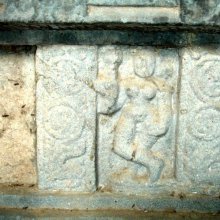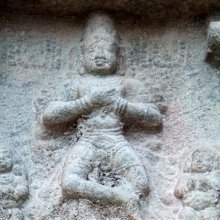Samotsarita: 2 definitions
Introduction:
Samotsarita means something in Hinduism, Sanskrit. If you want to know the exact meaning, history, etymology or English translation of this term then check out the descriptions on this page. Add your comment or reference to a book if you want to contribute to this summary article.
Images (photo gallery)
In Hinduism
Natyashastra (theatrics and dramaturgy)
Source: Wisdom Library: Nāṭya-śāstraSamotsarita (समोत्सरित) refers to a one of the twenty maṇḍalas, according to the Nāṭyaśāstra chapter 12. The Samotsarita-maṇḍala is classified as a ākāśa, or “aerial”, of which there are ten in total. A maṇḍala is a combination of cārīs (“dance-steps”), which refers refers to the simultaneous movement of the feet (pāda), shanks (jaṅghā) and the hip (ūru). From these cārīs proceed dance as well as movements in general.
Source: archive.org: Natya ShastraSamotsarita (समोत्सरित).—A type of maṇḍala (series of cārīs) classified as earthly (bhūmi);—Instructions:
1a) Assuming first of all the samapāda-sthāna,
1b) then stretching the two hands with their palms turned upwards,
2) Their intermittant āveṣṭana and udveṣṭana movements,
3) Then putting the left hand on the waist, the right hand moved in the āvartita manner,
4) The right hand to be put on the waist and the left hand moved in the āvartita manner,
5) Moving round alternately with this cārī, will give rise to the samotsarita-maṇḍala.

Natyashastra (नाट्यशास्त्र, nāṭyaśāstra) refers to both the ancient Indian tradition (shastra) of performing arts, (natya—theatrics, drama, dance, music), as well as the name of a Sanskrit work dealing with these subjects. It also teaches the rules for composing Dramatic plays (nataka), construction and performance of Theater, and Poetic works (kavya).
See also (Relevant definitions)
Starts with: Samotsaritamatalli.
Full-text: Mandala.
Relevant text
Search found 2 books and stories containing Samotsarita; (plurals include: Samotsaritas). You can also click to the full overview containing English textual excerpts. Below are direct links for the most relevant articles:
Gati in Theory and Practice (by Dr. Sujatha Mohan)
Performance of Gati through Maṇḍalas < [Chapter 2 - Concept and technique of Gati]
Gati in Maṇipurī < [Chapter 4 - Practice of Gati]
Natyashastra (English) (by Bharata-muni)


